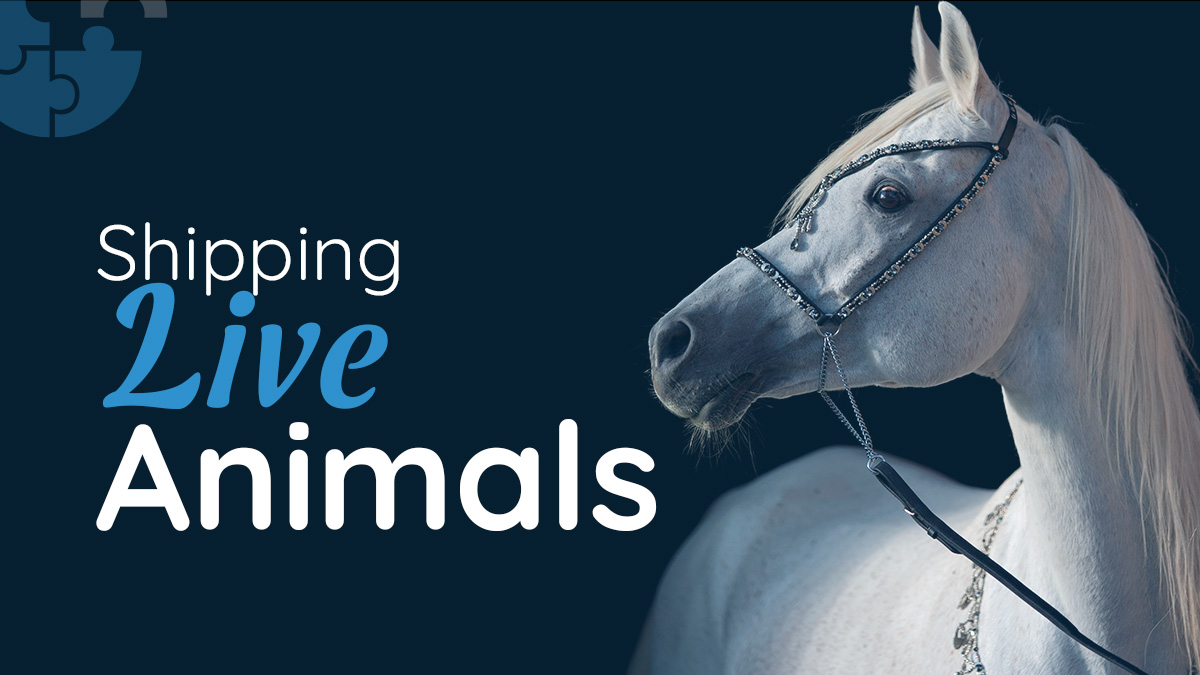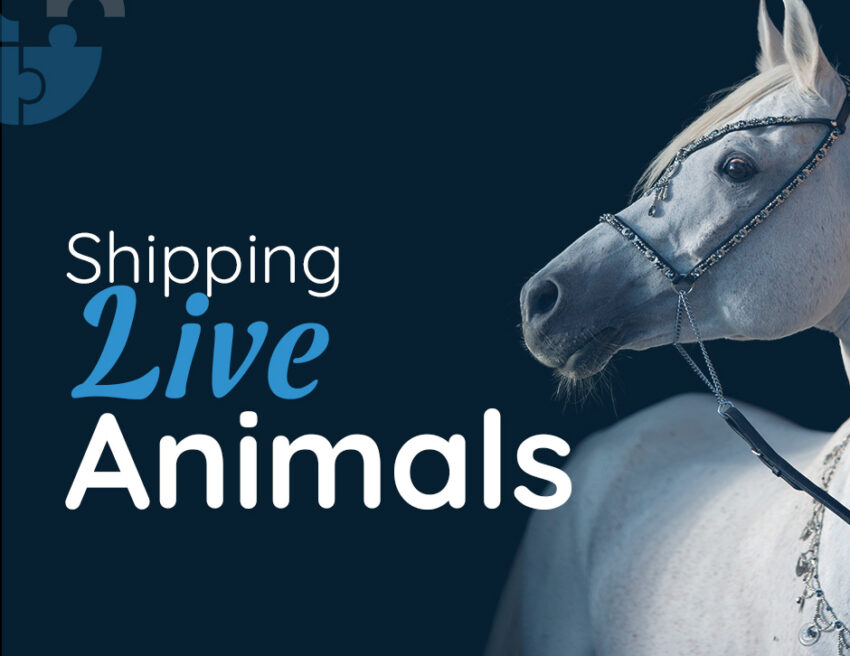World Animal Day 2024, celebrated on October 4th, serves as a global reminder of our shared responsibility to protect animal welfare. This annual event highlights the need to treat animals with respect and care, which extends to the logistics and transportation industry. When it comes to shipping live animals, independent freight forwarders play a critical role in ensuring the safe and humane transportation of various species across international borders.
Shipping live animals is a highly specialized segment of logistics that requires an in-depth understanding of both the ethical considerations and the regulatory complexities. This blog provides a detailed guide on the challenges, best practices, and essential factors that independent freight forwarders, need to consider when transporting live animals.

Understanding the Types of Live Animal Shipments
Live animal shipments can include a wide range of species, from pets like cats and dogs to exotic animals, livestock, and even endangered species. Moreover, each type of animal requires a tailored approach to transportation, with specific handling procedures, legal permits, and containment measures.
- Pets: Dogs, cats, birds, and other domestic animals often travel for relocation or pet trade. These shipments need extra care to minimize stress and ensure the animals’ health and safety.
- Livestock: Cows, horses, pigs, and poultry are frequently transported for agricultural purposes, and such shipments must meet veterinary and sanitary requirements.
- Exotic and Endangered Species: Animals like reptiles, birds of prey, and primates are subject to additional scrutiny under international conventions like the Convention on International Trade in Endangered Species (CITES).
Given the diverse range of animals, independent freight forwarders must familiarize themselves with the specific requirements for each type of shipment and adhere to the necessary regulations.
Regulations Governing Live Animal Shipping
Logistics companies shipping live animals must navigate complex regulations that vary from country to country. Understanding these legal frameworks is essential for ensuring compliance and avoiding hefty fines or the potential confiscation of animals.
International Air Transport Association (IATA) Live Animals Regulations (LAR)
IATA sets global standards for the safe and humane transport of live animals by air. Independent freight forwarders must be familiar with IATA’s guidelines, which cover everything from container specifications to ventilation and temperature control.
CITES
For exotic or endangered species, compliance with CITES is mandatory. Freight forwarders must obtain the required permits for shipping animals listed under CITES Appendices, ensuring that the animals are not illegally traded.
Animal Welfare Act (AWA)
Countries like the United States and the European Union have strict animal welfare regulations, with detailed provisions for the humane treatment of animals during transit. Freight forwarders must comply with veterinary health certifications, quarantine requirements, and pre-shipment inspections.
Veterinary Certificates and Quarantine
Many countries demand health certificates signed by accredited veterinarians. In some cases, animals may also be subjected to quarantine upon arrival, requiring the freight forwarder to coordinate with destination authorities.
By understanding these regulations, independent freight forwarders can ensure smooth operations and avoid delays that could negatively impact both the animals and the shipment.
Key Considerations for Shipping Live Animals
Shipping live animals requires attention to several critical factors, including transport modes, containers, health checks, and environmental conditions. Here are some essential considerations for independent freight forwarders:
1. Choosing the Right Mode of Transport
The primary transport modes for shipping live animals are air, sea, and road. Air transport is often the preferred choice due to its speed and ability to control environmental conditions more effectively. However, sea transport may be suitable for large-scale livestock shipments, while road transport is ideal for shorter distances.
Furthermore, freight forwarders must assess the duration of the journey and the specific needs of the animals to determine the best mode of transport. For example, air travel might be more suitable for time-sensitive shipments like pet relocations, while road transport can offer flexibility for large livestock movements within a region.
2. Selecting Appropriate Containers and Enclosures
One of the most important aspects of live animal transport is ensuring that the animals are placed in appropriate enclosures that meet IATA or other relevant standards. These containers must:
- Allow animals to stand, turn, and lie down comfortably.
- Provide adequate ventilation and temperature control.
- Be designed to prevent injury or escape.
For air shipments, specific IATA guidelines govern the design and materials of animal containers. Independent freight forwarders must ensure that the containers are not only compliant but also suitable for shipping the specific species.
3. Health Checks and Veterinary Considerations
Before shipping the animals, they must undergo health checks and receive veterinary certification. Freight forwarders must coordinate with veterinarians to ensure that the animals meet all destination country requirements regarding vaccinations, health status, and disease prevention.
For some animals, pre-shipment health inspections and even post-arrival quarantines are mandatory. Independent freight forwarders must work closely with both the shipper and destination authorities to ensure compliance with all health-related regulations.
4. Environmental and Safety Controls
Transporting live animals involves maintaining optimal environmental conditions throughout the journey. Additionally, there should be proper controlling of temperature, humidity, and light conditions to ensure the well-being of the animals. For example, some species may be sensitive to extreme temperatures or require specific lighting during transport.
Freight forwarders should ensure that carriers and handlers are trained in handling live animals, and that the transportation environment meets the specific needs of the species.
Best Practices for Independent Freight Forwarders
Independent freight forwarders can enhance the success of live animal shipments by following these best practices:
1. Build Strong Partnerships with Specialized Carriers:
Choosing the right carrier with experience in live animal transport is critical. Building relationships with airlines or sea freight companies that specialize in animal shipments will ensure proper and careful handling of the animals.
2. Prepare for Unforeseen Challenges:
Shipping live animals is inherently unpredictable. Delays, temperature fluctuations, and regulatory changes can occur at any point. Independent freight forwarders must plan for contingencies, including rerouting shipments, adjusting schedules, and ensuring access to veterinary services in case of emergencies.
3. Stay Updated on Regulatory Changes:
The regulatory landscape for live animal transport is constantly evolving. Independent freight forwarders should stay informed about updates to international conventions like CITES and national regulations to ensure ongoing compliance.
The Role of Independent Freight Forwarders in Live Animal Shipping
Independent freight forwarders play a vital role in coordinating live animal shipments across complex global supply chains. Their agility and expertise allow them to tailor services to the specific needs of each shipment, ensuring the animals’ safety and well-being throughout the process. By adhering to best practices, navigating the regulatory landscape, and coordinating with experienced carriers, independent freight forwarders can successfully manage the complexities of live animal transport.
On this World Animal Day 2024, let us remember that the safe and humane transportation of animals is a shared responsibility where freight forwarders should play a responsible role.


